Line Lite International BV 7W P7 CREE
Posted by Marcel van der Steen in Led lights, Light measurements Add commentsLine Lite International BV offers a beautiful and efficient led light bulb in E27 screw fitting. It shines warm white and with a very focused beam.
See this overview for a comparison with other light bulbs.
Summary measurement data
| parameter | meas. result | remark |
|---|---|---|
| Color temperature | 2751 K | Warm white |
| Luminous intensity Iv | 738 Cd | |
| Beam angle | 19 deg | Small beam angle. Focused light beam. |
| Power P | 8.2 W | |
| Power Factor | 0.66 | For every 1 kWh net power consumed, there has been 1.1 kVAhr for reactive power. |
| Luminous flux | 242 lm | |
| Luminous efficacy | 30 lm/W | |
| CRI_Ra | 84 | Color Rendering Index. |
| Coordinates chromaticity diagram | x=0.4625 and y=0.3989 | |
| Fitting | E27 | |
| D x H external dimensions | 74 x 103 mm | External dimensions of the light bulb. |
| Diameter luminous area | 45 mm | Dimensions of the luminous area (used in Eulumdat file). This is a circular area around the leds at the front. |
| General remarks | The ambient temperature during the whole set of measurements was 20.5 deg C.
Warm up effect: the illuminance as well as the consumed power are changing, about 20 % reduction. The parameters stabilize after 25 minutes. Voltage dependency: consumed power and illuminance are virtually not dependent from the light bulb voltage. |
|
| Measurement report (PDF) |
Eulumdat lichtdiagram
An interesting graph is the light diagram, indicating the intensity in the C0-C180 and the C90-C270 plane. This light diagram below comes from the program Qlumedit, that extracts these diagrams from an Eulumdat file.
The light diagram giving the radiation pattern.
It indicates the luminous intensity around the light bulb. This light bulb gives a very narrow beam. This light diagram is symmetrical around the z-axis.
The unit is Cd/1000lm, meaning the intensity in Cd assuming there would be 1000 lumen in the measured light bulb. This enables comparing different types of light bulbs.
Illuminance Ev at 1 m distance, or luminous intensity Iv
Herewith the plot of the averaged luminous intensity Iv as a function of the inclination angle with the light bulb.
The radiation pattern of the light bulb.
This radiation pattern is the same as the one given earlier. This is because in this light spot’s case, the radiation pattern is symmetric around the z-axis, meaning that the averaged pattern given here is the same as the extraction of the Eulumdat file.
These averaged values are used (later) to compute the lumen output.
Intensity data of every measured turn angle at each inclination angle.
This plot shows per inclination angle the intensity measurement results for each turn angle at that inclination angle.
When using the average values per inclination angle, the beam angle can be computed, being 19 degrees.
Luminous flux
With the averaged illuminance data at 1 m distance, taken from the graph showing the averaged radiation pattern,it is possible to compute the luminous flux.
The result of this computation for this light spot is a luminous flux of 242 lm.
Luminous efficacy
The luminous flux being 242 lm, and the power of the lightbulb being 8.2 W, yields a luminous efficacy of 30 lm/W.
A power factor of 0.66 means that for every 1 kWh net power consumed, a reactive component of 1.1 kVAr was needed.
| Light bulb voltage | 230 V |
| Light bulb current | 54 mA |
| Power P | 8.2 W |
| Apparent power S | 12.5 VA |
| Power factor | 0.66 |
Color temperature and Spectral power distribution
The spectral power distribution of this light bulb.
The measured color temperature is about 2750 K, close to warm white.
Chromaticity diagram
The chromaticity space and the position of the lamp’s color coordinates in it.
The light coming from this lamp is distant from the Planckian Locus (the black path in the graph).
Its coordinates are x=0.4625 and y=0.3989.
Color Rendering Index (CRI) or also Ra
Herewith the image showing the CRI as well as how well different colors are represented (rendered). The higher the number, the better the resemblance with the color when a black body radiator would have been used (the sun, or an incandescent lamp).
Each color has an index Rx, and the first 8 indexes (R1 .. R8) are averaged to compute the Ra which is equivalent to the CRI.
CRI of the light of this lightbulb.
The value of 84 is higher than 80 which is considered a minimum value for indoor usage.
Note: the chromaticity difference is 0.0061 indicates the distance to the Planckian Locus. Its value is (a little) higher than 0.0054, which means that the calculated CRI result is not meaningful.
Voltage dependency
The dependency of a number of lamp parameters on the lamp voltage is determined. For this, the lamp voltage has been varied and its effect on the following lamp parameters measured: illuminance E_v [lx], color temperature CT or correlated color temperature CCT [K], the lamppower P [W] and the luminous efficacy [lm/W].
Lamp voltage dependencies of certain light bulb parameters, where the value at 230 V is taken as 100 %.
The consumed power and the illuminance do depend little on the light bulb voltage.
Warm up effects
After switch on of a cold lamp, the effect of heating up of the lamp is measured on illuminance E_v [lx], color temperature CT or correlated color temperature CCT [K], the lamppower P [W] and the luminous efficacy [lm/W].
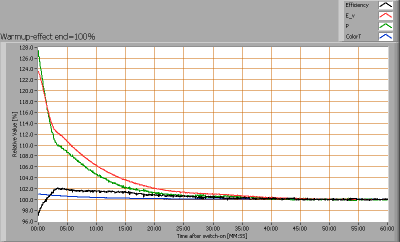
Effect of warming up on different light bulb parameters. At top the 100 % level is put at begin, and at bottom at the end.
The effect of warming up results in a decrease of the power ad illuminance of 20 %. The warm up period takes 25 minutes.
Luminous area
For the eulumdat file, when the luminous area is determined, it needs to know what part the light is coming from. This light bulb has 7 leds at the front, and the light is said to come from an area just around the leds at the front.

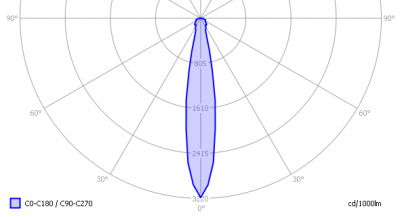
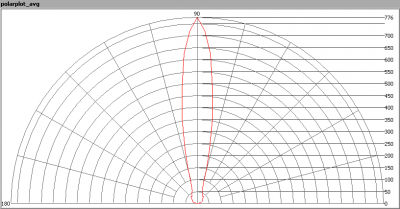
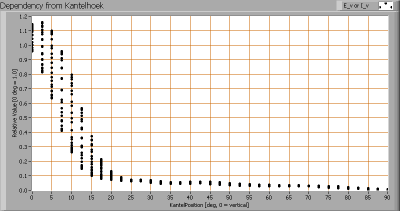
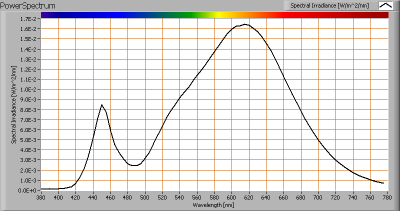

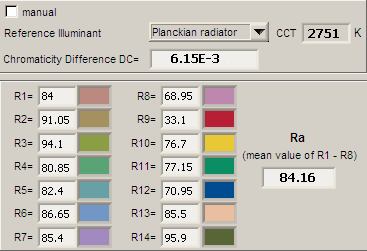
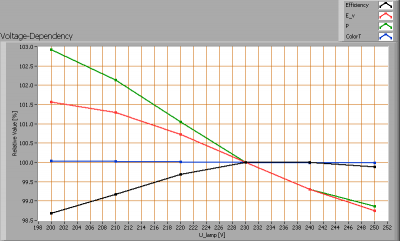
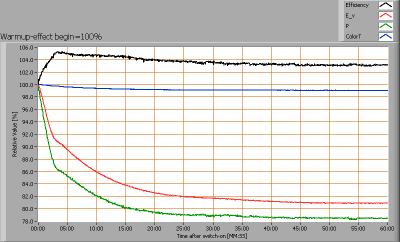
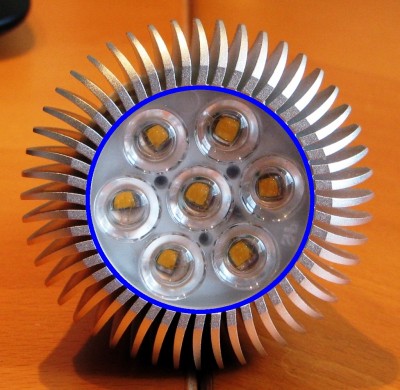



Most popular posts